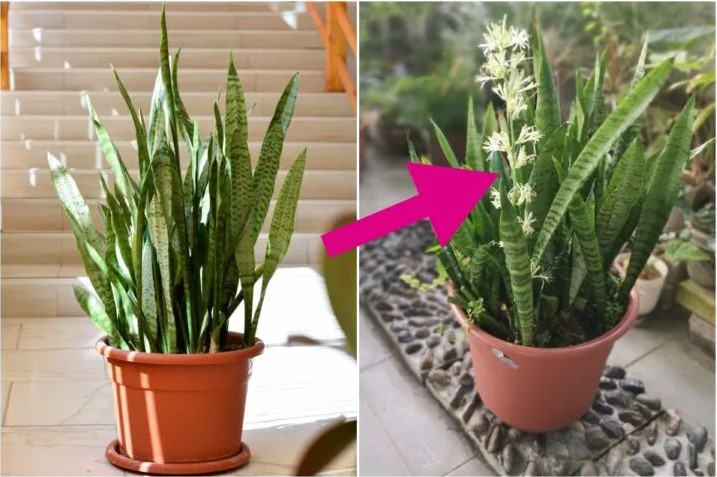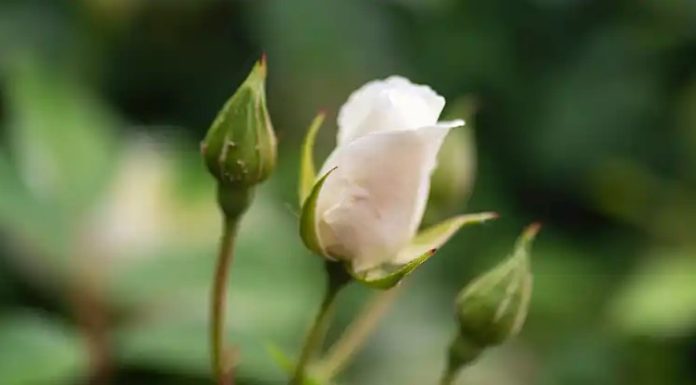When you think of blooming houseplants, I’ll bet you don’t think of snake plants. Yet, the recently reclassified Sansevieria trifasciata does, in fact, flower. They can bloom, usually once a year in the spring. But you wouldn’t think so to look at them. The (now) Dracaena trifasciata are tough plants.
Everything about these succulents comes off as slightly imposing.
From the long, sword-shaped leaves of Dracaena trifasciata to the spikey columns of Dracaena angolensis to how much neglect they can receive and still keep growing – these plants don’t mess around.
Heck, even their common names evoke menacing images: St. George’s Sword, mother-in-law tongue, snake plant.
It’s no wonder that the fragile blooms often take unsuspecting houseplant owners by surprise. Walking through their sun-filled living room one morning, coffee in hand, they notice something that wasn’t there before – a stalk of flowers.
 “Huh, I didn’t even know snake plants could flower.”
“Huh, I didn’t even know snake plants could flower.”
Of course, some of us know they flower, but we can’t seem to get our plant to do it.
To add insult to injury, it’s usually that friend or relation who offers haphazard care to their plants that find a surprise flower stalk rather than us. You know, the one who forgets to water their plants or doesn’t repot them when they’re supposed to. The one who casually mentions they have killed yet another houseplant.
No matter which camp you fall into – still striving toward a flower stalk or unwitting recipient of a snake plant bloom – knowing the conditions in which snake plants flower will help you achieve that goal.
Or explain why your houseplant-loving friend’s eye keeps twitching when you tell them about your lucky blooming snake plant.
Oddly enough, the key to a flowering snake plant reveals a hormonal link we share with our spikey little friend.
How to Get a Snake Plant to Bloom

Getting a snake plant to bloom all comes down to everyone’s favorite word – stress.
Okay, so maybe not everyone’s favorite word. (Did your shoulders hunch up a little when you read it?) But still, it’s what causes your spider plant to bloom and why some houseplant owners are a little hesitant to induce blooming in their plants but trust me, it turns out all right in the end.
There may even be flowers.
Stress – a Short Life Lesson & the Key to Blooming Snake Plants
Like most living creatures on this giant blue ball, plants are all about two things – surviving and producing more of themselves. If a plant becomes stressed and detects even the slightest chance that it won’t make it, it will turn its energy toward creating more copies of itself.
For most plants, that means producing flowers, which will produce seeds and, hopefully, the next generation. When environmental stressors begin to crop up, plants release hormones that start the process of producing flowers, snake plants included.
Of course, for us, stress is a four-letter word.

It’s only natural that when we think of intentionally putting stress on our plant, we tend to think the worst – a dead houseplant. That’s because we compare what we’re about to do to our plants with our experience with this word.
Stress isn’t bad. It’s there to keep us safe.
Our brains are inherently good at detecting things that can harm us. And when they do, our bodies flood with cortisol, preparing us to fight or flee from the lion we just heard hiding in the grass. But once we realize that the rustle in the grass was only the wind and not a lion about to devour us, the cortisol dissipates, and it’s no harm done.
Unfortunately, in our modern times, our brains mistake many common occurrences with deadly threats.
- Getting stuck in traffic when you’re already running late.
- Grabbing your mail and noticing that the Internal Revenue Service is one of the return addresses.
- Hearing your phone ring and seeing the number of an unwanted caller flash on the screen.
All these things trigger the release of cortisol, and all these tiny stressors add up, meaning we are now dealing with a constant and steady supply of cortisol with little to no abatement. We would be well past making flowers if we were plants.
 So, it’s no wonder that intentionally stressing a plant to get it to flower elicits a resounding “Nope!” from so many plant enthusiasts.
So, it’s no wonder that intentionally stressing a plant to get it to flower elicits a resounding “Nope!” from so many plant enthusiasts.
However, it takes minimal environmental stress to get your snake plant to flower. (Plants are pretty cautious like that.)
In fact, to get a snake plant to bloom indoors, you only need to change three specific growing conditions. Only two of these are stressful to the plant: letting the plant become root-bound and watering less frequently.
I’ll even put it into human stress scenarios.
It’s a bit like wearing that pair of jeans in the back of your drawer that are a smidge too snug because all your other pairs are in the laundry and how thirsty you feel in the evening if you forget to drink water all day.
Uncomfortable? Sure. Insurmountable? Hardly.
Naturally, if you put too much stress on a plant, the results will be disastrous, but that’s not what we’re after here.
The non-stress element? Light. Lots and lots of light.
Mild stress + light = a blooming snake plant.
Light Requirements
 Light is one of the most important factors when trying to induce a plant to flower, not just snake plants. If you have other flowering houseplants that have stopped blooming, like a peace lily or your African violet , fixing their light is usually enough to trigger blooms again.
Light is one of the most important factors when trying to induce a plant to flower, not just snake plants. If you have other flowering houseplants that have stopped blooming, like a peace lily or your African violet , fixing their light is usually enough to trigger blooms again.
Place your snake plant where it will receive bright, indirect sunlight. (An easy way to judge if it’s indirect light is that you shouldn’t be able to see the sun from where your plant is sitting.) Most houseplants can’t handle direct sun on their leaves and will burn. (That’s true plant stress.)
Usually, setting your plant near a south or east-facing window, but not in it, will provide the correct intensity of light needed.
If you want to be sure your plant is receiving the right light, you can purchase a light meter or download a light meter app on your phone, such as Lux Light Meter Pro . Bright indirect light should be over 10,000 lux to promote blooming.
However, it’s not simply the amount of light that’s important, but also the duration.
Indoor plants receive far less light than they would outdoors. As houseplant owners, we’re kind of terrible at estimating light needs. More often than not, we wrongly assume we’re providing an equivalent to what a plant would receive outdoors.

Even if you have your plants in a location that receives bright indirect sunlight, they may not receive enough of it throughout the day to trigger blooming.
The answer is to supplement with grow lights.
Your plant should receive 8-12 hours of bright indirect light daily. Setting up a grow light with a timer to turn on for a few hours in the morning or afternoon is the easiest way to ensure your plant receives enough light. Again, you may want to use a light meter to gauge whether or not the plant is receiving enough.
Let Your Snake Plant Wear Tight Jeans

Slightly rootbound plants will be under just enough stress to trigger blooming. However, severely rootbound plants won’t bloom and will stop growing altogether. How can you tell the difference?
A slightly rootbound plant will continue to grow, but its growth may be a bit slower than in previous years. You should see an even mix of roots and potting media if you gently lift the plant from the pot. A severely rootbound plant will stop growing altogether, with roots protruding from the bottom of the pot. If you lift the plant out of the pot, you will see mostly roots, as the root ball will have displaced most of the potting media.

If you want to trigger your snake plant to bloom, keep it in a small pot and only pot up once it has stopped growing. Move up to a slightly larger pot, no more than one inch larger in diameter.
Water Infrequently
Snake plants don’t need a lot of water to begin with. They do not like wet feet and prefer to dry out between waterings. During their active growth period, this equates to around once every two weeks. However, as the plant begins to slow its growth in the fall, you can stretch that out a bit. In the winter, you can even get away with watering them once a month. (See? Tough plants.)
 But if you want to induce flowering, you’ll want to water them even less frequently.
But if you want to induce flowering, you’ll want to water them even less frequently.
As most snake plants will flower in the spring, pay careful attention to when you water it as the plant emerges from dormancy. Once the days grow longer and things warm up, give it a good soaking and then let it really dry out, waiting about a week once it’s completely dry before watering again. Then, water sparingly, letting the plant dry completely before watering it again.
With the right amount of light, a snug pot, and infrequent watering, your plant will eventually push out a shoot at the base of a rosette. Within days, it will grow into a flower stalk. And who knows, it may take you by surprise one sunny morning, even if you’re looking for it.

The flowers exude a sticky nectar that hangs from the blossoms like dew drops. The flowers will open in the evenings, releasing a unique scent. Not many people get to experience this scent. So, if you get your snake plant to flower, take time to stop and smell them.
Post-bloom Care
Once your plant has finished blooming, it’s important to return to the normal standard of care. After all, the plant’s stress should be temporary, only long enough to induce flower production. (Lucky plant.)
Remove the flower stalk once the blooms have faded, and return to watering it as it dries out. If you’ve been supplementing with a grow light, you can stop using it.
Allow the plant to grow and renew its strength. You may even wish to repot your snake plant once it sufficiently recovers.
 Keep in mind that each rosette is only capable of blooming once. So don’t expect to repeat this flowery display too often in the future. But depending on the size of your plant, you can get other rosettes to bloom if you wish. While the snake plant isn’t generally considered a flowering plant, it’s worth the time and effort to experience it once.
Keep in mind that each rosette is only capable of blooming once. So don’t expect to repeat this flowery display too often in the future. But depending on the size of your plant, you can get other rosettes to bloom if you wish. While the snake plant isn’t generally considered a flowering plant, it’s worth the time and effort to experience it once.
And now, here we are, at the end of this article, and I hope you’ve learned a valuable lesson. Live like your snake plant: be tough but capable of fragile beauty; too much stress will kill you, but being slightly uncomfortable will cause you to bloom, especially if you surround yourself with light. Oh, and, of course, I hope you learned how to get your snake plant to flower.










